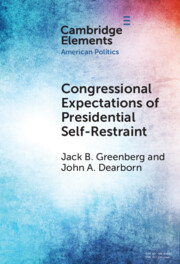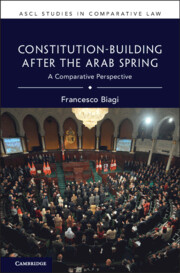Refine search
Actions for selected content:
105 results
Backdoor Executive Empowerment
-
- Journal:
- Legal Studies , FirstView
- Published online by Cambridge University Press:
- 26 September 2025, pp. 1-20
-
- Article
-
- You have access
- Open access
- HTML
- Export citation
Chapter 10 - Fundamental Aspects of Public Right
-
-
- Book:
- Kant's Lectures on Political Philosophy
- Published online:
- 18 July 2025
- Print publication:
- 07 August 2025, pp 179-198
-
- Chapter
- Export citation
19 - Recent Landmark Decisions
- from Part IV - Liability and Evidence
-
-
- Book:
- The Cambridge Handbook on Climate Litigation
- Published online:
- 03 June 2025
- Print publication:
- 31 July 2025, pp 472-497
-
- Chapter
-
- You have access
- Open access
- HTML
- Export citation
6 - Separation of Powers
- from Part I - Preliminary Issues
-
-
- Book:
- The Cambridge Handbook on Climate Litigation
- Published online:
- 03 June 2025
- Print publication:
- 31 July 2025, pp 145-168
-
- Chapter
-
- You have access
- Open access
- HTML
- Export citation
4 - Standing
- from Part I - Preliminary Issues
-
-
- Book:
- The Cambridge Handbook on Climate Litigation
- Published online:
- 03 June 2025
- Print publication:
- 31 July 2025, pp 105-130
-
- Chapter
-
- You have access
- Open access
- HTML
- Export citation
Reconciling Constitutional Values in Ghana Through Purposive Interpretation
-
- Journal:
- Journal of African Law , First View
- Published online by Cambridge University Press:
- 23 June 2025, pp. 1-22
-
- Article
-
- You have access
- Open access
- HTML
- Export citation
35 - Guarantor (or the So-called “Fourth Branch”) Institutions
- from Part III. A - The State
-
-
- Book:
- The Cambridge Handbook of Constitutional Theory
- Published online:
- 27 March 2025
- Print publication:
- 24 April 2025, pp 603-621
-
- Chapter
- Export citation
17 - The Separation of Powers
- from Part II - Modalities
-
-
- Book:
- The Cambridge Handbook of Constitutional Theory
- Published online:
- 27 March 2025
- Print publication:
- 24 April 2025, pp 279-296
-
- Chapter
- Export citation
The Burden of Proof in Immigration Bond Decisions: An Impact Study of Brito v. Barr
-
- Journal:
- Journal of Law and Courts ,
- Published online by Cambridge University Press:
- 24 April 2025, pp. 1-26
-
- Article
- Export citation
49 - Judicial Independence
- from Part III D - The Legal System
-
-
- Book:
- The Cambridge Handbook of Constitutional Theory
- Published online:
- 27 March 2025
- Print publication:
- 24 April 2025, pp 867-883
-
- Chapter
- Export citation

Congressional Expectations of Presidential Self-Restraint
-
- Published online:
- 15 April 2025
- Print publication:
- 22 May 2025
-
- Element
- Export citation
Judicial Legislation: The Supreme Court of Nigeria’s Model for Strategic Decision-Making?
-
- Journal:
- Journal of African Law / Volume 69 / Issue 2 / June 2025
- Published online by Cambridge University Press:
- 17 January 2025, pp. 233-251
- Print publication:
- June 2025
-
- Article
-
- You have access
- Open access
- HTML
- Export citation
2 - Systems of Government and Distribution of Powers
-
- Book:
- Constitution-Building After the Arab Spring
- Published online:
- 31 December 2024
- Print publication:
- 09 January 2025, pp 63-139
-
- Chapter
- Export citation

Constitution-Building After the Arab Spring
- A Comparative Perspective
-
- Published online:
- 31 December 2024
- Print publication:
- 09 January 2025
3 - The Rule of Law
-
- Book:
- Algorithmic Rule By Law
- Published online:
- 14 December 2024
- Print publication:
- 12 December 2024, pp 95-150
-
- Chapter
-
- You have access
- Open access
- HTML
- Export citation
5 - Complementarity, Structure, and Ambivalence
- from Part II - Remedies beyond the CJEU
-
-
- Book:
- Redressing Fundamental Rights Violations by the EU
- Published online:
- 21 December 2024
- Print publication:
- 12 December 2024, pp 123-154
-
- Chapter
-
- You have access
- Open access
- HTML
- Export citation
17 - The Role of Judges in Implementing Climate Policies
- from Part II - Designing Effective Governance Mechanisms
-
-
- Book:
- Implementing Climate Change Policy
- Published online:
- 22 November 2024
- Print publication:
- 05 December 2024, pp 271-286
-
- Chapter
-
- You have access
- Open access
- HTML
- Export citation
6 - Separation of Powers and Federalism
- from Part II - Symmetry Applied
-
- Book:
- Constitutional Symmetry
- Published online:
- 14 November 2024
- Print publication:
- 21 November 2024, pp 145-178
-
- Chapter
- Export citation
5 - Separating and Distributing Powers and Functions
- from Part II - Structural Considerations
-
- Book:
- Good Governing
- Published online:
- 23 October 2024
- Print publication:
- 17 October 2024, pp 173-199
-
- Chapter
-
- You have access
- Open access
- HTML
- Export citation
The Rule of Law: A Core Premise for the Effectiveness of International Environmental Law
-
- Journal:
- European Journal of Risk Regulation / Volume 15 / Issue 3 / September 2024
- Published online by Cambridge University Press:
- 04 June 2024, pp. 572-587
-
- Article
- Export citation
